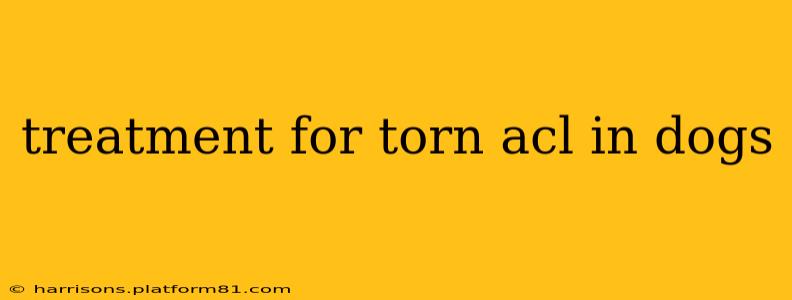A torn anterior cruciate ligament (ACL), also known as a cranial cruciate ligament (CCL) rupture, is a common and debilitating injury in dogs. Understanding the various treatment options is crucial for pet owners facing this diagnosis. This guide will explore the different approaches, helping you make informed decisions for your canine companion.
What is a Torn ACL in Dogs?
The ACL is a vital ligament in the knee joint, providing stability and preventing hyperextension. A tear, often caused by sudden twisting or jumping, can result in pain, lameness, and instability. Breed predisposition plays a significant role; larger breeds like Labrador Retrievers, Golden Retrievers, and Rottweilers are statistically more prone to ACL tears. The severity of the tear ranges from a partial tear to a complete rupture.
How is a Torn ACL Diagnosed in Dogs?
Diagnosis typically involves a thorough physical examination by your veterinarian. This includes assessing your dog's gait, range of motion, and response to palpation of the knee joint. Further diagnostic imaging, such as X-rays, may be necessary to rule out other injuries and confirm the diagnosis. While X-rays don't directly visualize the ligament, they can show secondary signs like joint swelling or arthritis.
What are the symptoms of a torn ACL in dogs?
Symptoms often include sudden lameness, limping, stiffness, swelling around the knee, and limited range of motion. Your dog might also experience pain when the knee is touched or manipulated. The severity of symptoms depends on the extent of the tear.
Treatment Options for a Torn ACL in Dogs
Several treatment options exist, each with its advantages and disadvantages:
1. Conservative Management (Non-Surgical):
This approach focuses on managing pain and inflammation, aiming to allow the body to heal naturally. It involves rest, restricted activity, pain medication (NSAIDs), and physiotherapy. Conservative management is most effective for partial tears or in cases where surgery is too risky due to other health concerns. Success rates are variable, however, and it may not be suitable for all dogs or tear severities.
2. Surgical Intervention:
Surgery is often necessary for complete ACL tears, especially in larger dogs or those with significant instability. Several surgical techniques exist:
2a. Tibial Plateau Leveling Osteotomy (TPLO):
TPLO is a common procedure that involves altering the angle of the tibia to reduce stress on the knee joint. It's considered a highly effective method with a good long-term prognosis, but it's a more complex and costly procedure.
2b. Tibial Tuberosity Advancement (TTA):
Similar to TPLO, TTA addresses the biomechanics of the knee joint to stabilize it without replacing the ACL. It also shows high success rates and can be a good alternative to TPLO.
2c. Extracapsular Repair:
This technique involves using sutures or other implants to support the knee joint externally. While less invasive than TPLO or TTA, it's generally less effective and has a higher risk of re-rupture.
3. Post-Surgical Care and Rehabilitation:
Regardless of the chosen surgical method, post-operative care is crucial. This includes strict confinement and gradual return to activity following the vet's instructions. Physical therapy plays a key role in regaining strength and mobility.
How long does it take for a dog to recover from a torn ACL?
Recovery time varies depending on the treatment method and your dog's individual healing process. Conservative management might take several months, while surgery requires a more extended period of rehabilitation, often lasting several weeks to months.
What is the cost of ACL surgery for dogs?
The cost of ACL surgery varies widely based on location, surgeon, and the specific surgical technique. It's crucial to discuss the financial implications with your veterinarian before proceeding.
Can a dog recover from a torn ACL without surgery?
While some dogs may recover with conservative management, particularly those with partial tears, complete tears often require surgery for optimal long-term outcome and to prevent the development of arthritis.
How can I prevent a torn ACL in my dog?
Maintaining a healthy weight, regular exercise (avoiding high-impact activities), and providing a supportive environment can help reduce the risk. Strengthening exercises can also improve joint stability.
This comprehensive overview provides a foundation for understanding ACL tears in dogs. Remember to consult with your veterinarian for a personalized diagnosis and treatment plan tailored to your dog’s specific needs and condition. Early intervention is key for the best possible outcome.
